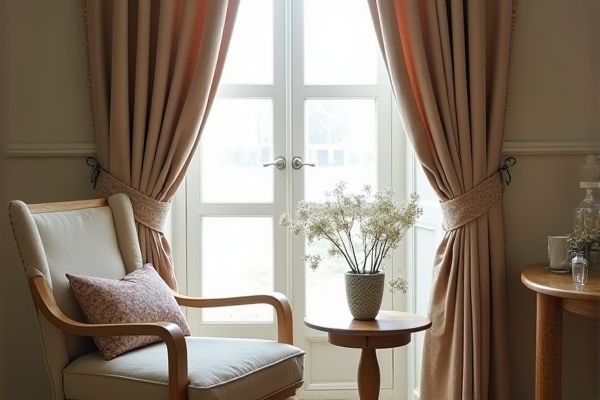
Linen curtains offer a light, breathable texture that enhances natural light while providing a casual, airy feel, whereas velvet curtains add a rich, luxurious thickness that improves insulation and blocks out light effectively. Discover which option best suits your style and functional needs by reading the rest of the article.
Table of Comparison
| Feature | Linen Curtains | Velvet Curtains |
|---|---|---|
| Material | Natural flax fibers | Dense woven fabric, often silk or synthetic blend |
| Appearance | Light, airy, textured | Rich, plush, luxurious |
| Light Control | Moderate, filters sunlight | High, blocks most light |
| Insulation | Minimal thermal insulation | Excellent thermal and sound insulation |
| Durability | Strong but prone to wrinkles | Durable and resistant to wear |
| Maintenance | Machine washable or dry clean | Usually dry clean only |
| Style | Casual, natural, coastal | Formal, elegant, opulent |
| Cost | Moderate | High |
Introduction: Comparing Linen and Velvet Curtains
Linen curtains offer a lightweight, breathable fabric that enhances natural light and provides a casual, airy ambiance in any room. Velvet curtains, by contrast, deliver a rich, luxurious texture with excellent insulation and light-blocking properties, ideal for creating a cozy, elegant atmosphere. Choosing between linen and velvet curtains depends on desired aesthetics, room functionality, and durability requirements.
Material Overview: Linen vs Velvet
Linen curtains offer a lightweight, breathable fabric made from natural flax fibers, known for their durability and subtle texture that enhances natural light flow. Velvet curtains provide a luxurious, dense material typically made from silk, cotton, or synthetic fibers, delivering a rich texture and superior insulation. The choice between linen and velvet hinges on preferences for light filtration, insulation, and aesthetic value in home decor.
Aesthetic Appeal: Style Differences
Linen curtains offer a light, airy aesthetic with a natural texture that complements minimalist and coastal decor schemes, creating a relaxed and inviting atmosphere. Velvet curtains provide a rich, luxurious appearance with a dense pile that adds depth and elegance, perfect for traditional or opulent interior styles. Your choice between linen and velvet curtains will influence the overall vibe of your space, balancing softness and sophistication according to your decor preferences.
Texture and Feel: Touch and Draping
Linen curtains offer a light, breathable texture with a natural, slightly rough feel that drapes softly and creates an airy, casual ambiance. Velvet curtains provide a rich, plush texture with a smooth, luxurious touch and heavy draping that offers a dramatic, elegant appearance. The tactile contrast directly influences room aesthetics, with linen enhancing brightness and velvet emphasizing opulence.
Light Control and Privacy
Linen curtains allow natural light to filter through softly, creating an airy ambiance while offering moderate privacy by blurring the view from outside. Velvet curtains provide superior light control by blocking out sunlight more effectively, ensuring maximum privacy and darkness, making them ideal for bedrooms or media rooms. Choosing between linen and velvet curtains depends on your preference for balancing natural light with privacy needs in your space.
Insulation and Energy Efficiency
Linen curtains provide lightweight insulation, allowing natural light to pass through while reducing heat loss during mild weather, making them suitable for moderate climates. Velvet curtains offer superior thermal insulation due to their dense, thick fabric, effectively trapping heat and improving energy efficiency in colder environments. Choosing the right curtain material can significantly impact your home's temperature regulation and energy bills.
Maintenance and Cleaning Requirements
Linen curtains require gentle washing or dry cleaning, as their natural fibers are prone to shrinking and wrinkles, demanding careful maintenance to preserve texture and color. Velvet curtains need professional dry cleaning to maintain their plush texture and prevent damage from water or heat, making them higher-maintenance but durable if cared for properly. Your choice depends on whether you prefer the easy freshness of linen or the luxurious look of velvet that requires more attentive cleaning routines.
Durability and Longevity
Linen curtains offer moderate durability with a natural resistance to fading, making them ideal for spaces with indirect sunlight, while their lightweight fabric may show wear over time. Velvet curtains provide superior longevity due to their dense pile and robust fibers, resisting daily wear and retaining appearance in high-traffic areas. Choosing between linen and velvet depends on balancing aesthetic preference with the desired lifespan and maintenance requirements of the curtains.
Cost Comparison: Linen vs Velvet
Linen curtains generally offer a more budget-friendly option compared to velvet, with prices averaging $20 to $40 per yard for linen versus $50 to $100 per yard for velvet. The cost difference is influenced by the natural fiber and lightweight texture of linen, which requires less intensive manufacturing than the dense, luxurious pile of velvet. Choosing linen over velvet can significantly reduce expenses, especially for large window treatments or multiple panels.
Best Room Applications and Design Suggestions
Linen curtains are ideal for living rooms, kitchens, and bedrooms where natural light and breathability enhance comfort, complementing casual or Scandinavian-style interiors. Velvet curtains suit formal spaces like dining rooms, home theaters, or master bedrooms, providing a luxurious, insulating effect that adds depth and richness to traditional or modern glam designs. You can mix linen curtains with neutral palettes and light wood furniture for an airy feel, while pairing velvet curtains with dark hues and metallic accents creates a dramatic, elegant ambiance.
 homyna.com
homyna.com